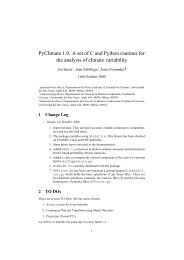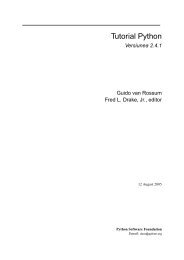PyClimate 1.1. A set of C and Python routines for the ... - Starship
PyClimate 1.1. A set of C and Python routines for the ... - Starship
PyClimate 1.1. A set of C and Python routines for the ... - Starship
You also want an ePaper? Increase the reach of your titles
YUMPU automatically turns print PDFs into web optimized ePapers that Google loves.
temporal subsampling <strong>of</strong> <strong>the</strong> original data<strong>set</strong>. Given <strong>the</strong> original data<strong>set</strong> <strong>and</strong> (possibly,some <strong>of</strong>) <strong>the</strong> EOFs <strong>of</strong> <strong>the</strong> whole data<strong>set</strong> as returned by svde<strong>of</strong>s() (e<strong>of</strong>s), thisfunction builds several subsamples chosing <strong>the</strong> records in <strong>the</strong> original data<strong>set</strong> at r<strong>and</strong>om.The subsamples are <strong>of</strong> length length, which must be smaller than <strong>the</strong> length <strong>of</strong><strong>the</strong> original data<strong>set</strong>. The function returns a Numeric array <strong>of</strong> shape (subsamples,e<strong>of</strong>s.shape[-1])) which holds <strong>the</strong> congruence coefficients <strong>of</strong> <strong>the</strong> master i(wholesample) <strong>and</strong> perturbed (subsample) eigenvectors <strong>for</strong> each subsample <strong>and</strong> eigenvector.8 SVD <strong>of</strong> coupled data<strong>set</strong>sThe SVD decomposition <strong>of</strong> <strong>the</strong> covariance matrix <strong>of</strong> two data<strong>set</strong>s is one <strong>of</strong> <strong>the</strong> simplest,yet powerful, method to analyze <strong>the</strong> linear relationship between two coupled geophysicaldata<strong>set</strong>s [1, 4, 9, 15]. Some functions that implement most <strong>of</strong> <strong>the</strong> computationsusually needed <strong>for</strong> this analysis are provided in <strong>the</strong> file svd.py. One example on <strong>the</strong>use <strong>of</strong> <strong>the</strong>se functions is in <strong>the</strong> file testsvd.py.Function: def svd(xfield,yfield)Given two fields í (xfield) <strong>and</strong> î (yfield), defined as in section 7 (first dimension <strong>of</strong><strong>the</strong> array is <strong>the</strong> temporal one), this function returns <strong>the</strong> SVD decomposition <strong>of</strong> <strong>the</strong>ircovariance ïñðiòrófôõ‹ö ÷ matrix . It returns a tuple <strong>of</strong> three ø arrays ù , ú <strong>and</strong> . Eachcolumn ûü holds <strong>the</strong> ý –eth singular vector <strong>of</strong> <strong>the</strong> left (í ) field. Same convention isfollowed by <strong>the</strong> ordering <strong>of</strong> elements in ú . ù is a one–dimensional array which holds<strong>the</strong> singular values þ!ü . The singular vectors are orthonormal (ûÎü¼ÿiû¡ ¹ó£¢¼ü˜ÿ¤¢¥ ªó§¦iü¨ )<strong>and</strong> can be used to linearly project each <strong>of</strong> <strong>the</strong> fields to define <strong>the</strong> expansion coefficients© ü óñÿ°ûÎü <strong>and</strong>oü ó ÿ¢¼ü whose covariance is <strong>the</strong> same as <strong>the</strong> singularvalue associated to that þ ü ó . The data<strong>set</strong>s are centered (sample meanis removed) inside <strong>the</strong> function prior to <strong>the</strong> SVD computation. NEW: Since versionmode1.1, <strong>the</strong> data <strong>set</strong>s may have arbitrary dimensions, but <strong>the</strong> leading one must be time.As in <strong>the</strong> case <strong>of</strong> EOF decomposition <strong>the</strong> fields can also be entered as more–than–two–dimensional arrays <strong>and</strong> <strong>the</strong> returned matrices will be accordingly reshapedto avoid <strong>the</strong> user to care about <strong>the</strong> internal use <strong>of</strong> two–dimensional matrices. The©SVDpatterns are returned as generalized columns in <strong>the</strong> sense described in <strong>the</strong> EOFüsection.üFunction: def getcoefs(data,svectors)Given a data<strong>set</strong> (í data î or ) <strong>and</strong> <strong>the</strong> corresponding <strong>set</strong> <strong>of</strong> singular (ø vectors or) returned by svd(), this function returns <strong>the</strong> expansion coefficients ú ü oriü ) up(©to <strong>the</strong> order stated by <strong>the</strong> evaluation <strong>of</strong> svectors.shape[-1])). This, in fact,means truncating <strong>the</strong> representation <strong>of</strong> <strong>the</strong> field at this number. This same approach isused in <strong>the</strong> next two <strong>routines</strong>. The output Numeric arrays hold <strong>the</strong> coefficients in eachcolumn. That is, <strong>the</strong> expansion coefficients associated to <strong>the</strong> i–eth singular vector are:coefs[:,i].Function: def getcoefcorrelations(scoefs, zcoefs)Given <strong>the</strong> left <strong>and</strong> right SVD expansion coefficients returns an one–dimensional arraycontaining <strong>the</strong> paired correlation <strong>of</strong> <strong>the</strong> corresponding coeffients.Function: def homogeneousmaps(data,svectors)From <strong>the</strong> input data<strong>set</strong> data <strong>and</strong> <strong>the</strong> array svectors, returns an array with as manyhomogeneous correlation maps ((í ûÎü or î ¢¼ü) as ending subarrays (singularvectors) are in svectors. Each subarray <strong>the</strong>maps[...,imap] is <strong>the</strong> imap–ethmap.Function: def heterogeneousmaps(xdata,ycoefs)From <strong>the</strong> input data<strong>set</strong> xdata <strong>and</strong> <strong>the</strong> array <strong>of</strong> expansion coefficients ycoefs, it returns11









